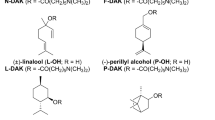Abstract
Effects of solubility, partition coefficient, and selected adjuvants (propylene glycol and Azone) on percutaneous penetration of isoproterenol HC1 have been investigated using human cadaver skin. Isoproterenol was found to be stable (<1% decomposition) for 24 hr at 22 ± 0.5°C in the pH range 1 to 7 in the following solvents: water, normal saline, propylene glycol and a series of propylene glycol–water mixtures (10, 20, 40, and 60%; v/v); however, decomposition was significant beyond pH 8. In normal saline, the rate of decomposition increased significantly with an increase in temperature to 37°C. The solubility of isoproterenol HC1 decreased and its skin/vehicle partition coefficient increased with increasing proportions of propylene glycol in the vehicle, while the product of the solubility and partition coefficient appeared to plateau at 20% propylene glycol in water. Optimal penetration enhancing effects of Azone were seen when incorporated at a concentration of 1% (v/v) in the 20% (v/v) propylene glycol–water blend and, more significantly, when skin was pretreated with pure Azone for 60 min prior to application of the drug formulation.
Similar content being viewed by others
REFERENCES
R. Girdwood. Clinical Pharmacology, Baillier Tindall, London, 1984, pp. 21–226, 316–318.
D. Aviado. Sympathomimetic Drugs, Charles C Thomas Publisher, Springfield, Il., 1970 pp. 367–409.
C. T. Dollery, D. S. Davies, and M. E. Conolly. Arch. Int. Pharmacodyn. Ther. 192:214–219 (1971).
C. D. Morgan, C. R. J. Ruthven, and M. Sandler. Clin. Chim. Acta 26:381–386 (1969).
A. G. Ghanekar and V. Das Gupta. J. Pharm. Sci. 67:1247–1250 (1978).
The United States Pharmacopeia XX, U.S. Pharmacopoeial Convention, Rockville, Md., 1975.
K. H. Valia and Y. W. Chien. Drug Dev. Indust. Pharm. 10:951–981 (1984).
S. M. Harrison, B. W. Barry, and P. H. Dugard. J. Pharm. Sci. 36:261–262 (1984).
J. Swarbrick, G. Lee, and J. Brom. J. Invest. Dermatol. 78:63–66 (1982).
B. V. Iyer and R. C. Vasavada. Int. J. Pharm. 3:247–260 (1979).
B. Mollgaard and A. Hoelgaard. Acta. Pharm. Suec. 20:433–442 (1983).
B. Mollgaard and A. Hoelgaard. Acta. Pharm. Suec. 20:443–450 (1983).
A. BenKorah and R. C. Vasavada. Master's thesis, University of the Pacific, Stockton, Calif., 1985.
Author information
Authors and Affiliations
Rights and permissions
About this article
Cite this article
Patel, R.A., Vasavada, R.C. Transdermal Delivery of Isoproterenol HC1: An Investigation of Stability, Solubility, Partition Coefficient, and Vehicle Effects. Pharm Res 5, 116–119 (1988). https://doi.org/10.1023/A:1015996319406
Issue Date:
DOI: https://doi.org/10.1023/A:1015996319406




